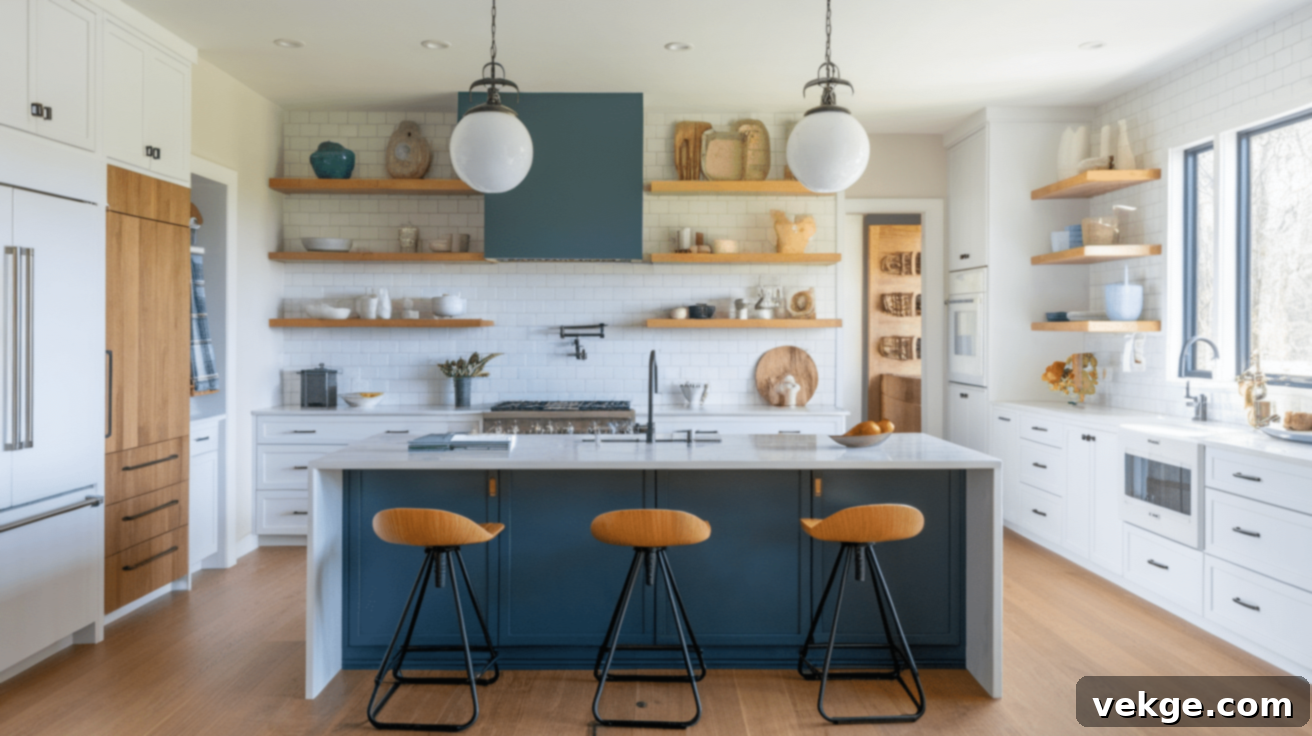The Ultimate Guide to Modern Kitchen Cabinet Trends: Styles, Materials, & Renovation Tips for This Year
More than just practical storage units, your kitchen cabinets are the visual backbone of your cooking space, profoundly influencing its aesthetic, atmosphere, and overall functionality. As a central element in kitchen design, they set the stage for everything from your daily meal preparation to elaborate entertaining, making their style choice crucial.
As design philosophies evolve, kitchen cabinets stand at the forefront of innovation, offering an exciting array of new directions and possibilities. From captivating two-tone compositions and the embracing of natural materials to sophisticated smart storage solutions and integrated technologies, today’s cabinet trends provide countless opportunities to express your unique style while significantly enhancing your kitchen’s usability and flow.
This comprehensive guide delves into the most compelling kitchen cabinet trends worth considering for your next home improvement project. We’ll help you identify outdated styles to avoid, ensuring your investment stands the test of time and remains relevant for years to come. Additionally, we’ll share practical, actionable tips for selecting options that perfectly complement your home’s architectural style, your personal lifestyle, and your budget.
Whether you’re embarking on a full-scale kitchen renovation or simply seeking to refresh your existing space with a thoughtful update, the insights within this article will empower you to create a kitchen that is not only strikingly current but also possesses a timeless appeal, enduring comfort, and superior functionality.
Current Kitchen Cabinet Trends to Elevate Your Home Design
The role of kitchen cabinets extends far beyond mere utility; they establish the entire mood and character of your culinary sanctuary. In contemporary design, homeowners are increasingly moving away from homogenous, all-white kitchens, opting instead for designs that infuse personality and depth through thoughtful choices in color, texture, and intelligent layouts. These emerging cabinet styles flawlessly combine improved functionality with stunning aesthetics, catering to a diverse range of home styles and personal tastes, ensuring your kitchen is both beautiful and highly efficient.
1. Two-Tone Cabinetry: A Dynamic Visual Statement
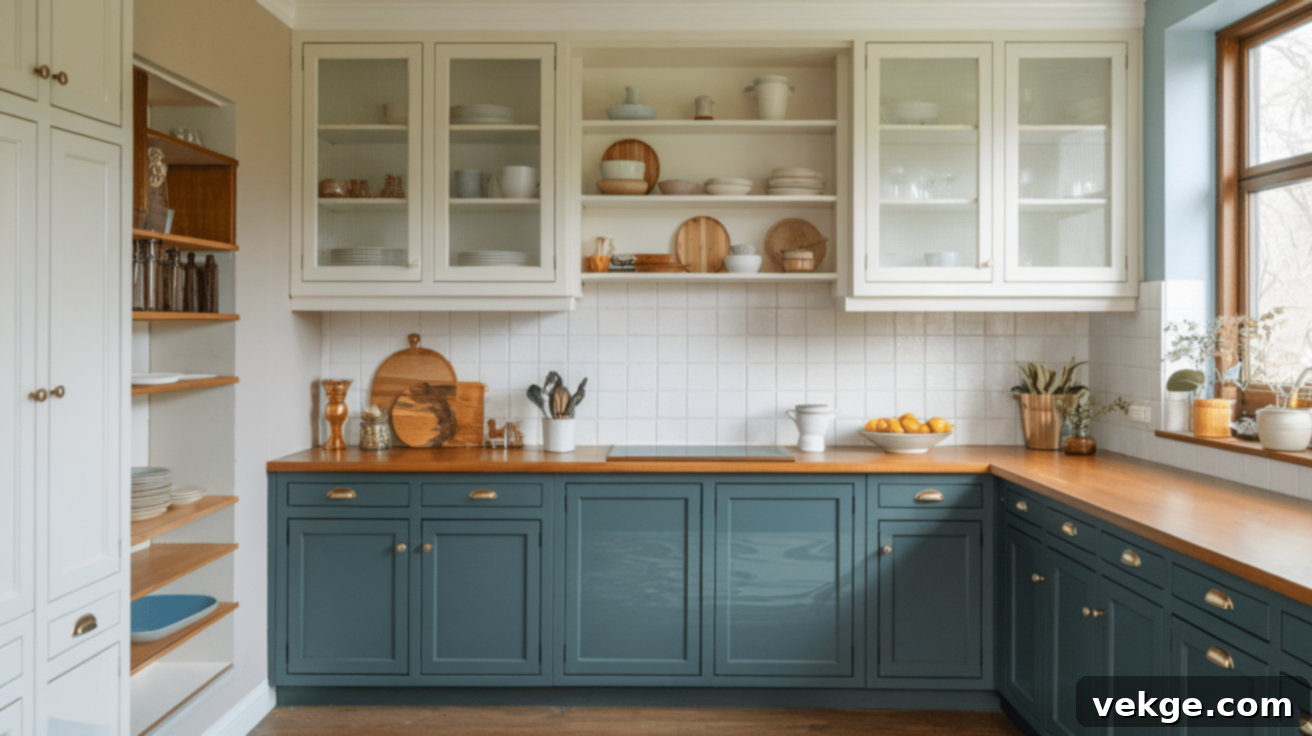
Two-tone cabinetry involves combining two distinct colors or finishes for your upper and lower cabinets, or between your main perimeter cabinets and a kitchen island. This trend creates a visually captivating effect, adding significant depth, dimension, and contrast to the kitchen. It allows for a highly personalized look, breaking up the visual monotony that can sometimes arise from a single-color scheme and making the space feel more curated and dynamic.
Many designers and homeowners strategically choose lighter hues for upper cabinets to maintain an open and airy feel, especially in smaller spaces, while grounding the room with darker, richer shades for lower cabinets or a central island. This approach creates a beautiful balance, making the kitchen feel bright and spacious yet anchored and sophisticated. It’s an excellent way to introduce color without overwhelming the space, and it also allows you to highlight architectural features or specific zones within the kitchen, such as a bar area or a breakfast nook.
2. Blue and Green Cabinets: Embracing Nature’s Palette
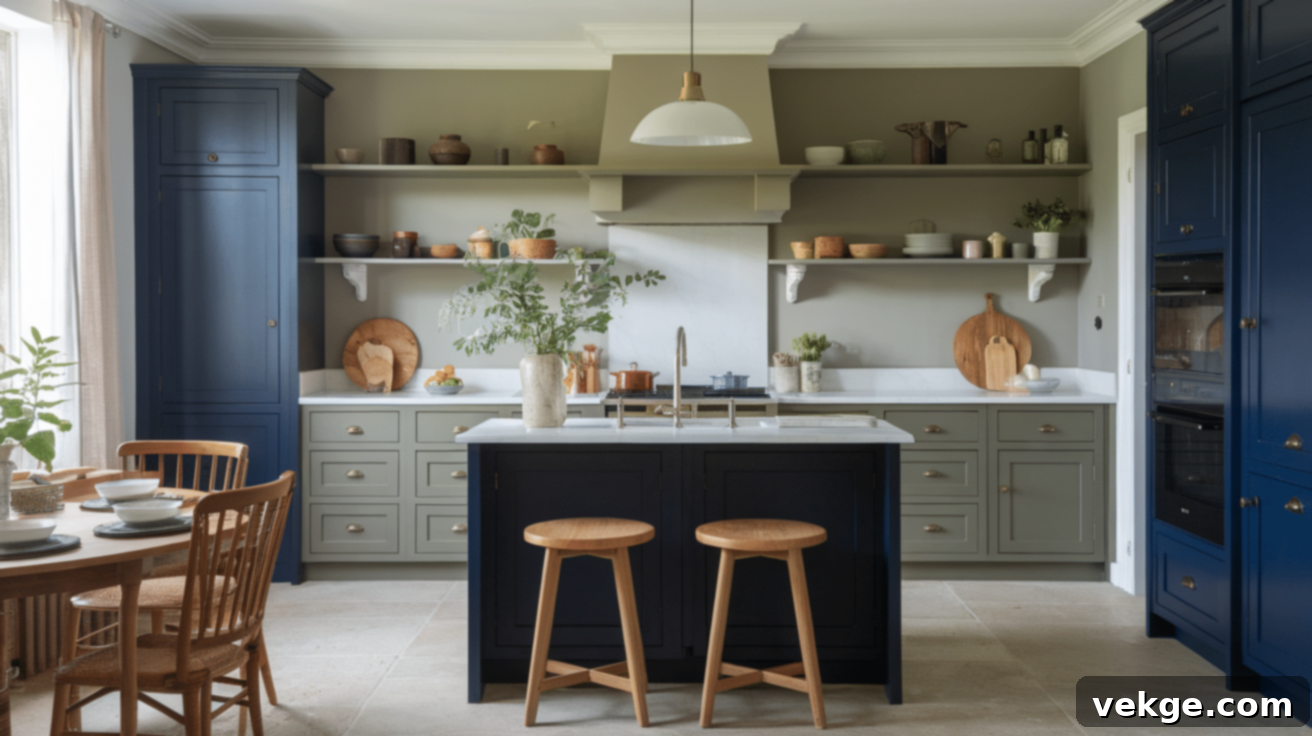
Moving beyond predictable neutrals, earthy and organic tones like serene olive green and sophisticated navy blue are taking center stage in kitchen design. These colors inject a unique personality and evoke a natural, calming ambiance, transforming the kitchen into a tranquil retreat. They offer a refreshing alternative to traditional whites and grays, bringing the soothing influence of the outdoors inside and creating a more inviting atmosphere.
Green cabinets, particularly in muted olive, sage, or forest tones, elegantly nod to ’70s vintage aesthetics while feeling entirely contemporary and fresh. They pair wonderfully with natural wood accents, brass hardware, and white or marble countertops. Blue cabinets, ranging from deep navy to soft sky shades or vibrant teal, introduce a profound sense of peace and stability to even the busiest kitchen environments. Both color families are incredibly versatile, complementing various design styles from modern farmhouse and coastal contemporary to mid-century modern, and can be used sparingly as an accent or boldly throughout the entire kitchen.
3. Shaker Cabinets: Timeless Simplicity and Enduring Versatility
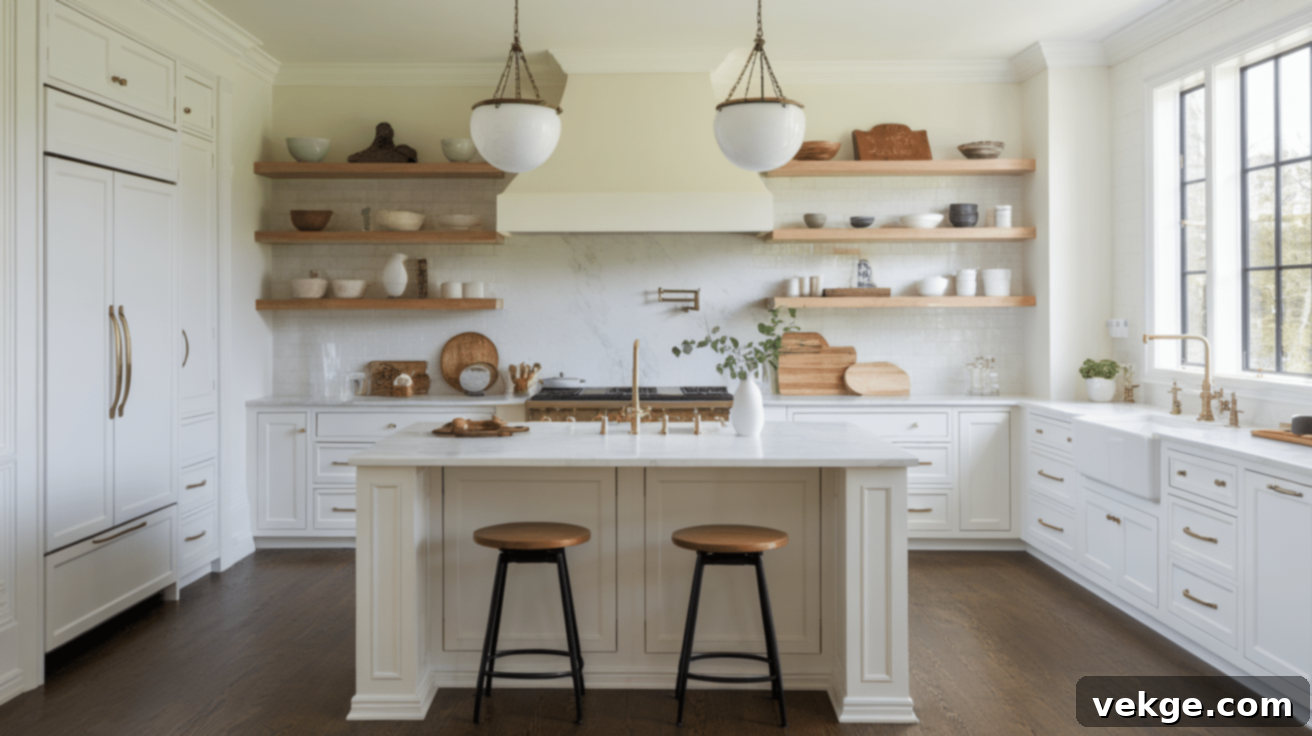
Shaker cabinets continue their reign as a perennial favorite, celebrated for their straightforward yet elegant design. Characterized by simple, flat-panel doors with a recessed center panel and clean lines, they effortlessly bridge the gap between traditional charm and modern minimalism. Their enduring appeal lies in their adaptability, making them suitable for a vast array of home styles, from classic country kitchens to sleek, contemporary urban spaces, providing a universal foundation.
The uncluttered aesthetic of Shaker cabinets ensures they resist fleeting trends, remaining a smart, timeless choice that won’t quickly feel outdated. This fundamental simplicity also makes them incredibly flexible: they can be painted in virtually any color, from crisp whites and muted grays to bold blues and greens, allowing homeowners to customize their kitchen’s look without sacrificing the classic foundation. Their clean lines also make them easy to clean and maintain, adding to their practical appeal.
4. Open Shelving: Airiness and Display Potential
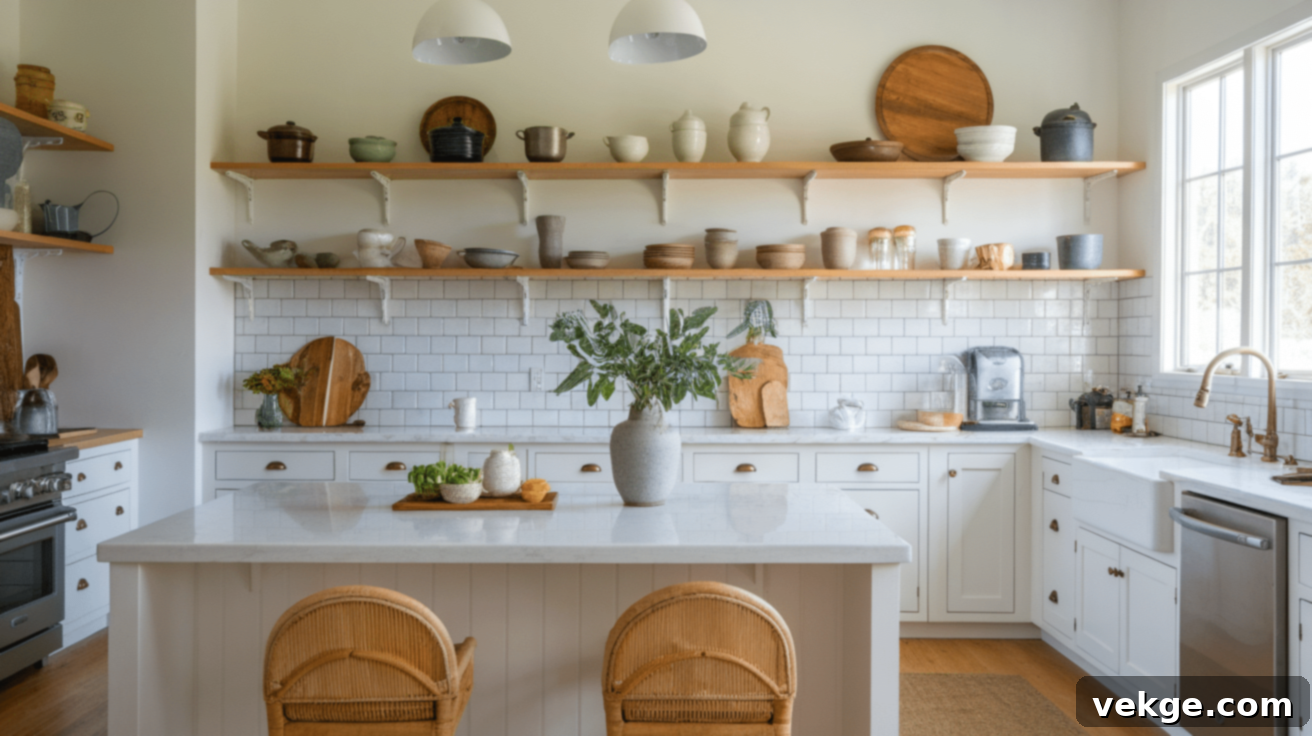
The trend of replacing traditional upper cabinets with open shelving creates an immediate sense of openness and airiness in the kitchen. This style is not only aesthetically pleasing but also highly practical, offering an ideal platform for displaying cherished kitchenware, curated decor, and frequently used items. It instantly transforms a kitchen into a more inviting and less enclosed space, making it feel larger, brighter, and more welcoming.
Open shelves are particularly effective in smaller kitchens, where they can prevent the space from feeling cramped or heavy, enhancing the perception of depth and light. They also provide unparalleled easy access to everyday items, streamlining your cooking process and making essentials readily available. From a budgetary perspective, open shelving often presents a more cost-effective alternative to traditional enclosed cabinets, making it an attractive option for many homeowners seeking a stylish update without a hefty price tag. However, it requires a commitment to organized and visually appealing displays to maintain a tidy look.
5. Bold Cabinet Colors: A Powerful Personal Expression
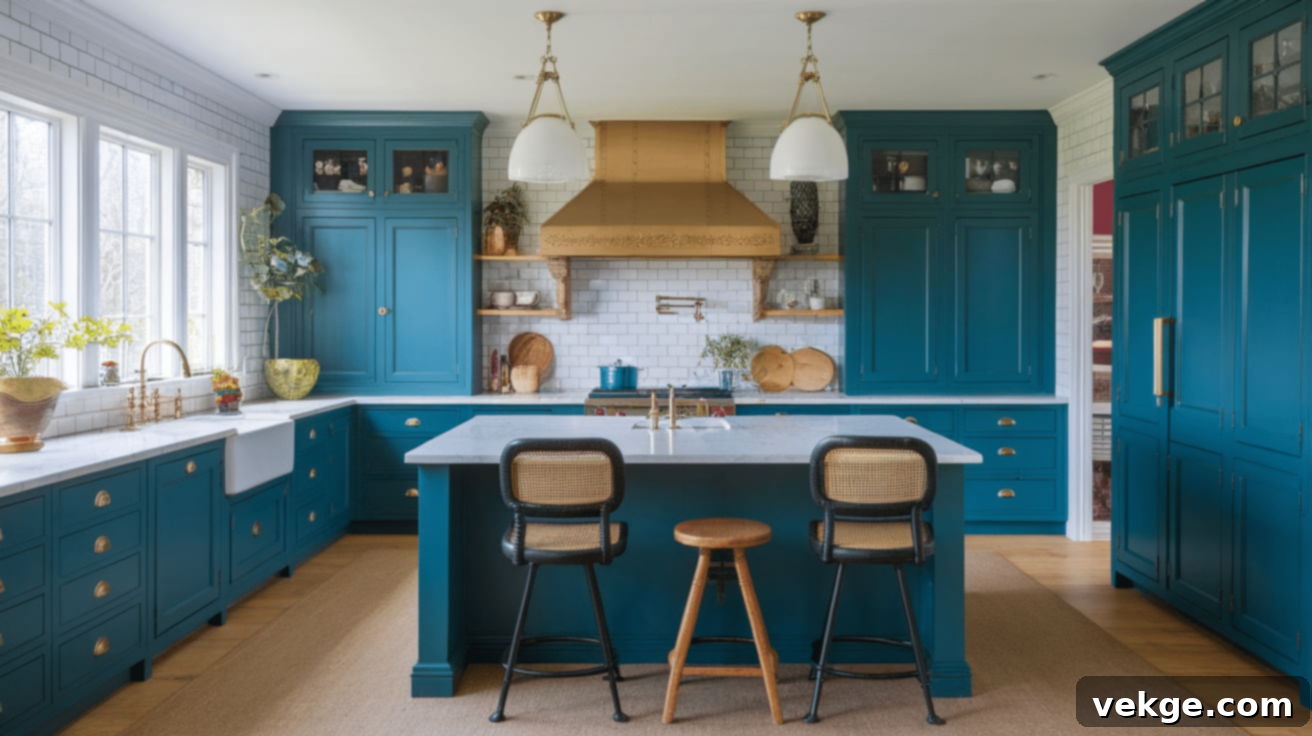
The design world is confidently stepping away from an exclusive reliance on neutral whites and grays, instead embracing a spectrum of vibrant, statement-making hues for kitchen cabinetry. Choosing bold colors is a powerful way to reflect personal style and create a dramatic focal point within the kitchen, transforming it from a purely functional area into a true reflection of the homeowner’s personality and taste, adding a unique signature to the space.
More homeowners are now using their kitchens as a canvas for self-expression through adventurous color choices. This significant shift from the sterile “all-white” kitchen adds much-needed warmth, depth, and character to the heart of the home. Whether it’s a rich burgundy, a deep forest green, a playful yellow, or a sophisticated charcoal, bold cabinets can set a joyful, sophisticated, or dramatic tone, making the kitchen feel truly unique, memorable, and full of life. They can be used on all cabinets or strategically on an island or lower units for a pop of color.
6. Countertop Cabinets: Seamless Storage and Streamlined Design
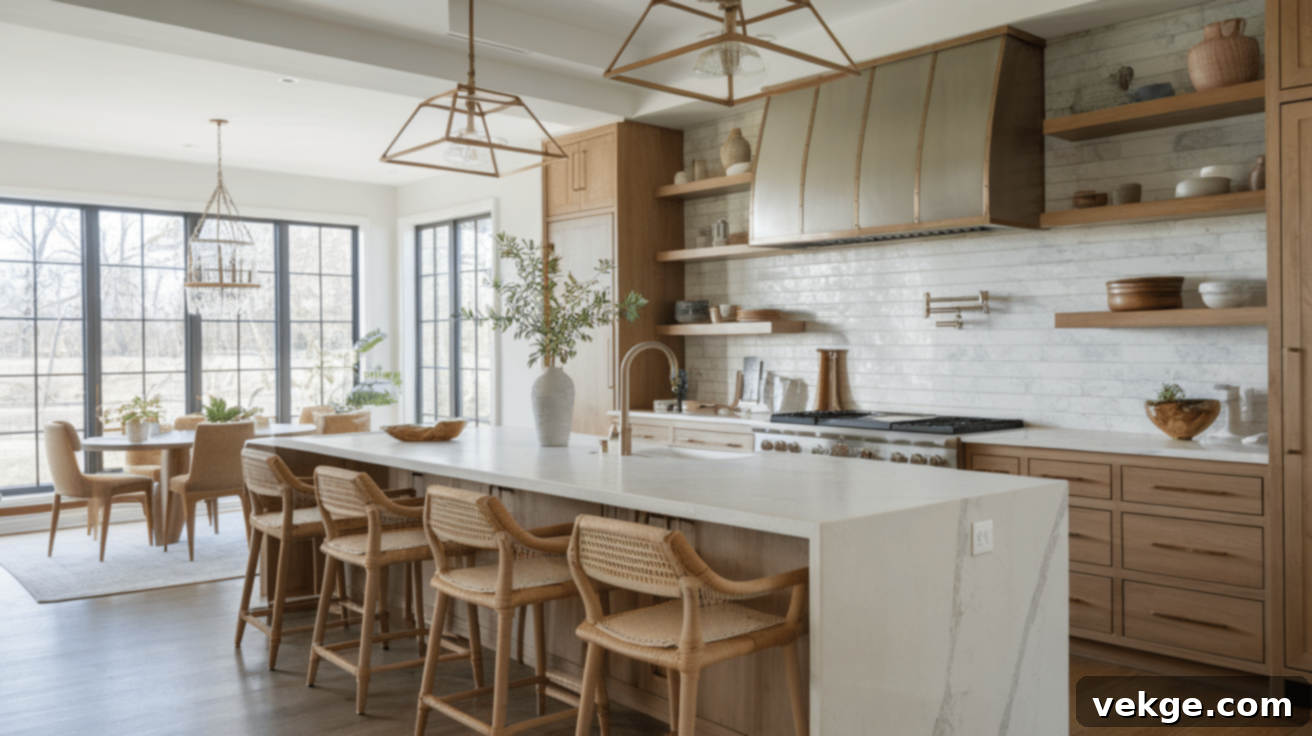
Countertop cabinets, often referred to as “appliance garages,” “hutch-style” cabinets, or “tall wall cabinets,” are designed to extend all the way down to the countertop. This clever design maximizes accessible storage without compromising on style or flow, creating a built-in, furniture-like appearance. They are excellent for tucking away small appliances like coffee makers, toasters, and blenders, as well as cookbooks or everyday items, keeping countertops gloriously clutter-free and visually appealing.
By eliminating the typical gap between upper cabinets and countertops, these units provide valuable extra storage space while simultaneously creating a clean, unbroken line that contributes to a more integrated and well-planned kitchen aesthetic. This seamless look can make a kitchen feel more custom-built and sophisticated, adding both practical utility and a polished design element. They can be designed with solid doors or glass fronts to either conceal or display items.
7. Inset Cabinetry: Precision and Classic Elegance
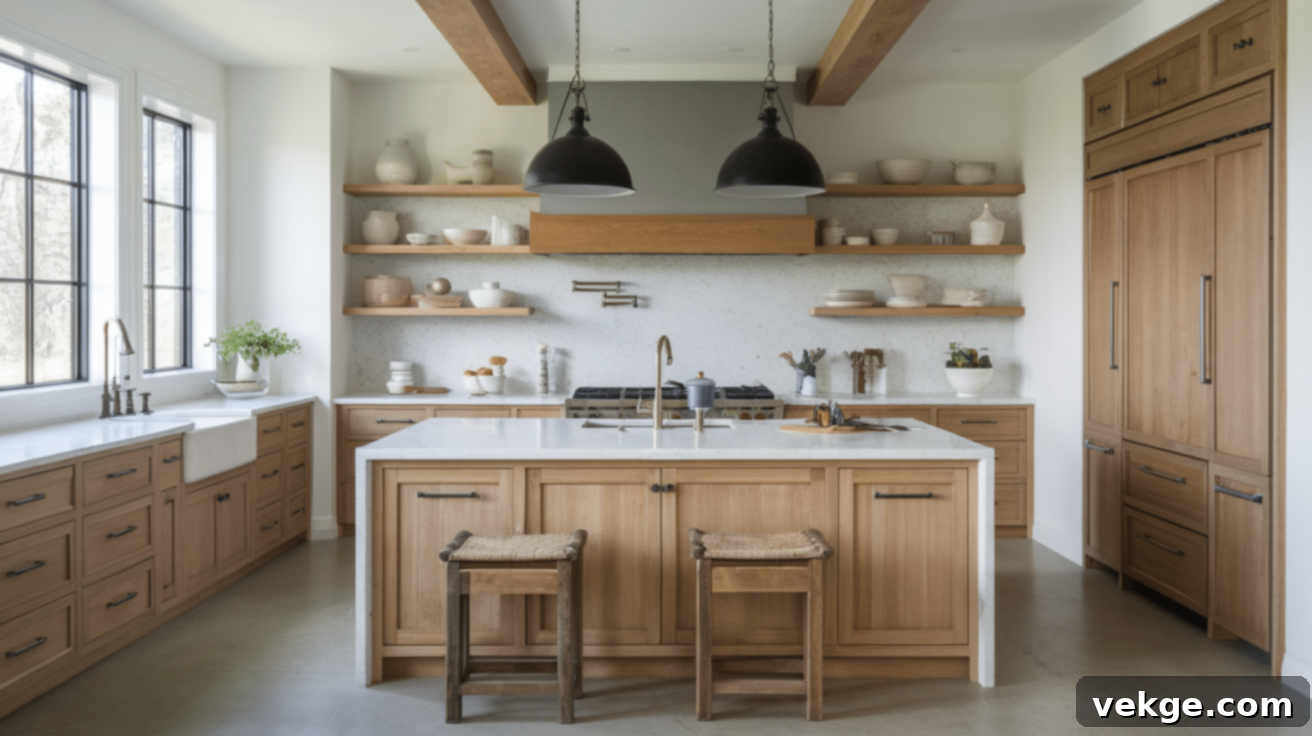
Inset cabinetry is a premium style where cabinet doors and drawer fronts are meticulously fitted to sit precisely flush with the cabinet frame, revealing the frame around each door and drawer. This meticulous construction creates a sleek, seamless, and undeniably high-end look. It’s a design choice that embodies superior craftsmanship and exceptional attention to detail, resulting in a clean, refined appearance that excels in both classic and contemporary kitchen settings.
The tight spacing and perfectly flush alignment of the doors and drawers create a timeless appeal, reminiscent of fine furniture. This style stands out for its careful craftsmanship, as the precision required in its construction makes it a hallmark of quality. While often associated with traditional, bespoke kitchens, the minimalist nature of inset fronts can also be adapted for modern designs that prioritize clean lines and understated luxury. This style often comes with a higher price point due to the precision required, but its sophisticated aesthetic and durability make it a worthwhile investment for those seeking lasting elegance.
8. Arched Cabinet Doors: Softness and Architectural Grace
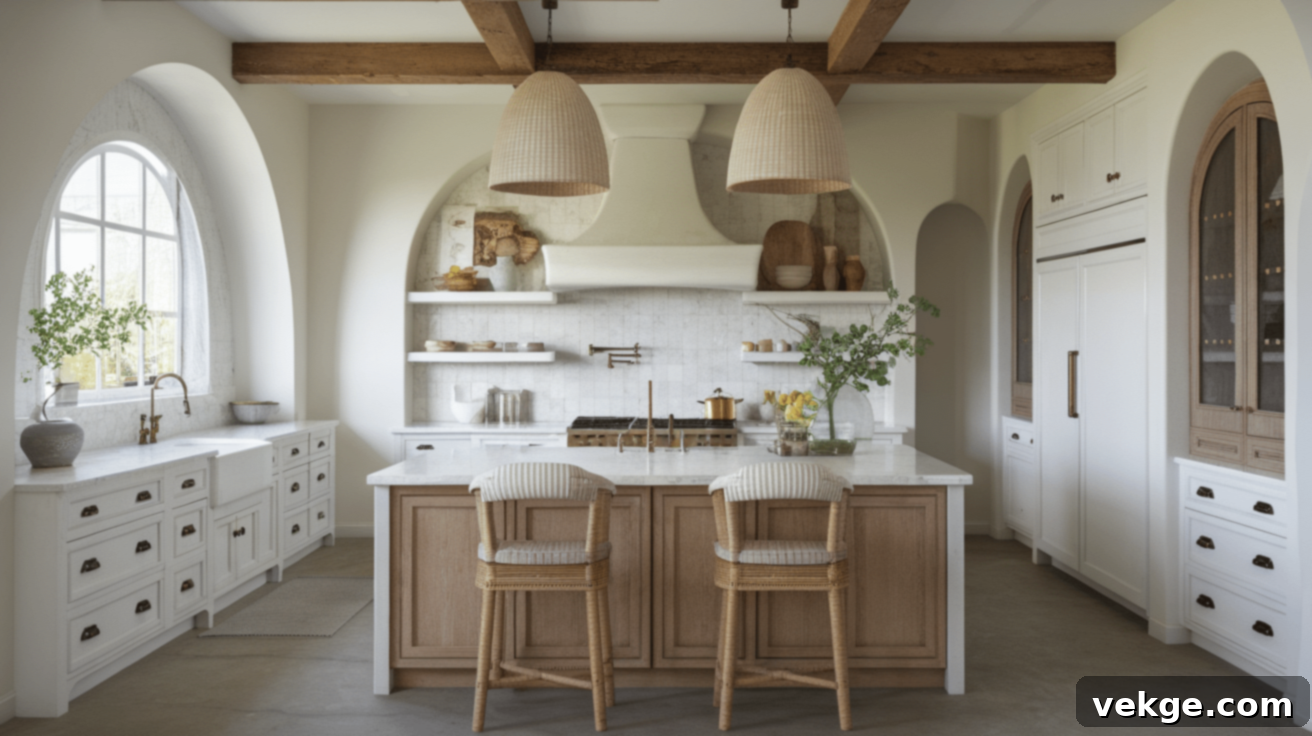
Moving away from rigid straight lines, arched cabinet doors introduce gentle curves and soft arches into kitchen design. These elegant doors add a touch of architectural grace and a more natural, fluid flow to the kitchen’s overall aesthetic. They evoke a sense of heritage and bespoke craftsmanship, softening the often-angular nature of kitchen layouts and introducing a unique visual rhythm.
The subtle curves inherently create a more welcoming and less austere feel in the kitchen, fostering a sense of comfort and classic charm. This style is perfect for homeowners looking to inject a unique character and a hint of vintage or Mediterranean charm without sacrificing a clean, structured appearance. Arched cabinet doors can complement various home styles, from traditional and transitional to even some modern farmhouse designs, adding visual interest and a sense of refined artistry that sets your kitchen apart.
9. Integrated Appliances: A Seamless and Minimalist Vision

Integrated appliances are a hallmark of modern, minimalist kitchen design, where major appliances are artfully concealed behind custom cabinet panels that perfectly match the surrounding cabinetry. This approach creates a cohesive and visually uninterrupted kitchen environment, giving a sleek, contemporary feel while fully maintaining functionality. When refrigerators, dishwashers, and even microwaves seamlessly match the surrounding cabinet fronts, the kitchen transcends its utilitarian purpose and blends more harmoniously with adjacent living spaces, often appearing more like a living room than a dedicated work area.
The smooth, unbroken lines achieved through integrated appliances create an unparalleled sense of order and sophistication. This design choice is particularly beneficial in smaller kitchens, as it minimizes visual clutter and can make the space appear significantly larger and more expansive. It embodies a philosophy where efficiency meets understated elegance, allowing the beauty of the cabinetry and overall design to truly shine without the visual interruption of stainless steel or appliance facades.
10. Vintage and Retro Styles: Nostalgic Charm Reimagined
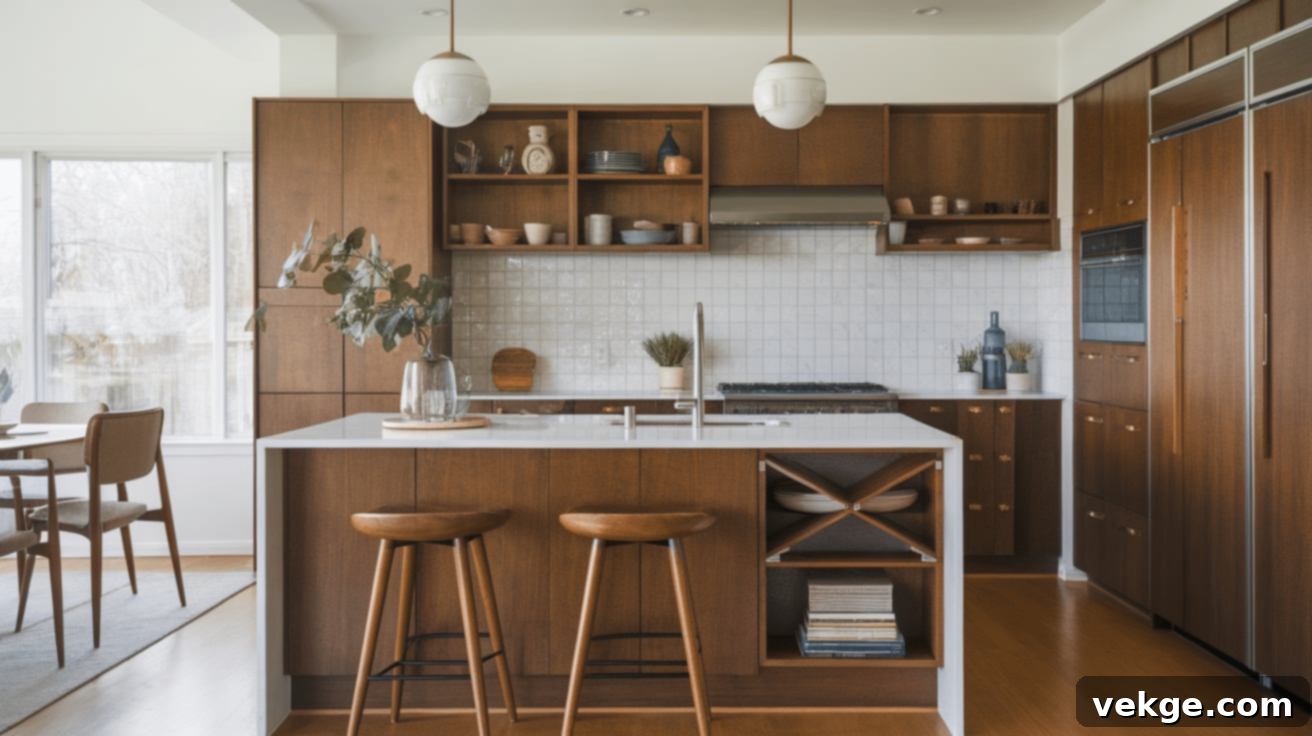
The enduring appeal of the past is celebrated in the resurgence of vintage and retro-inspired designs for kitchen cabinetry. Incorporating elements from mid-century modern, Art Deco, or even early 20th-century aesthetics, these nostalgic designs offer a unique blend of warmth, character, and lasting appeal. They provide a refreshing contrast to purely contemporary styles, creating kitchens that feel rich with history and personality, often with a playful twist.
These styles inject a soulful warmth and distinctive character into kitchens, drawing a direct line to design history while still feeling incredibly relevant and fresh. Mid-century modern influences, characterized by clean lines, simple forms, warm wood tones, and sometimes vibrant color accents, integrate beautifully into today’s homes, offering a sophisticated yet inviting atmosphere. Retro elements like atomic-era patterns, classic diner aesthetics, or iconic color palettes (e.g., avocado green, burnt orange, or mustard yellow) can also be subtly introduced to add a playful and unique touch, making the kitchen a conversation starter.
11. Customizable Storage Solutions: Maximizing Efficiency
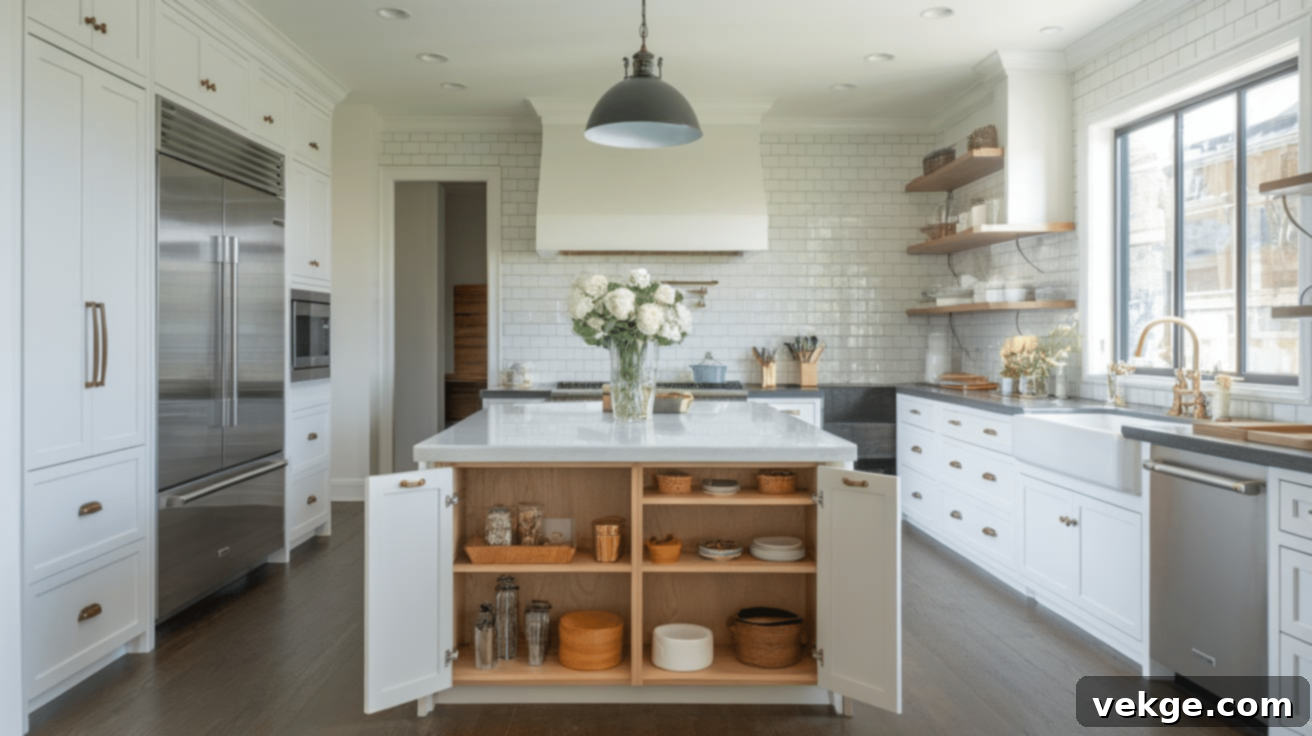
Modern kitchen design places a strong emphasis on smart functionality and organization, leading to a rise in customizable storage solutions built directly into cabinetry. These intelligent features include a wide array of built-in systems such as pull-out pantry shelves, integrated spice racks, hidden waste and recycling bins, deep drawers with customizable dividers for pots and pans, corner cabinet pull-outs (like Lazy Susans), and specialized appliance garages or charging stations. These innovations dramatically improve kitchen efficiency, organization, and ease of use, transforming clutter into order.
Contemporary cabinets are meticulously designed to make cooking and daily tasks more streamlined and enjoyable. Smart storage solutions ensure that every inch of available space is utilized effectively, which is especially crucial in smaller kitchens where maximizing storage without sacrificing aesthetics is paramount. This trend caters directly to the practical needs of homeowners, transforming potentially cluttered cabinets into highly organized, accessible, and functional spaces, reducing stress and enhancing the overall cooking experience.
12. Minimalist Designs: Understated Elegance and Serenity
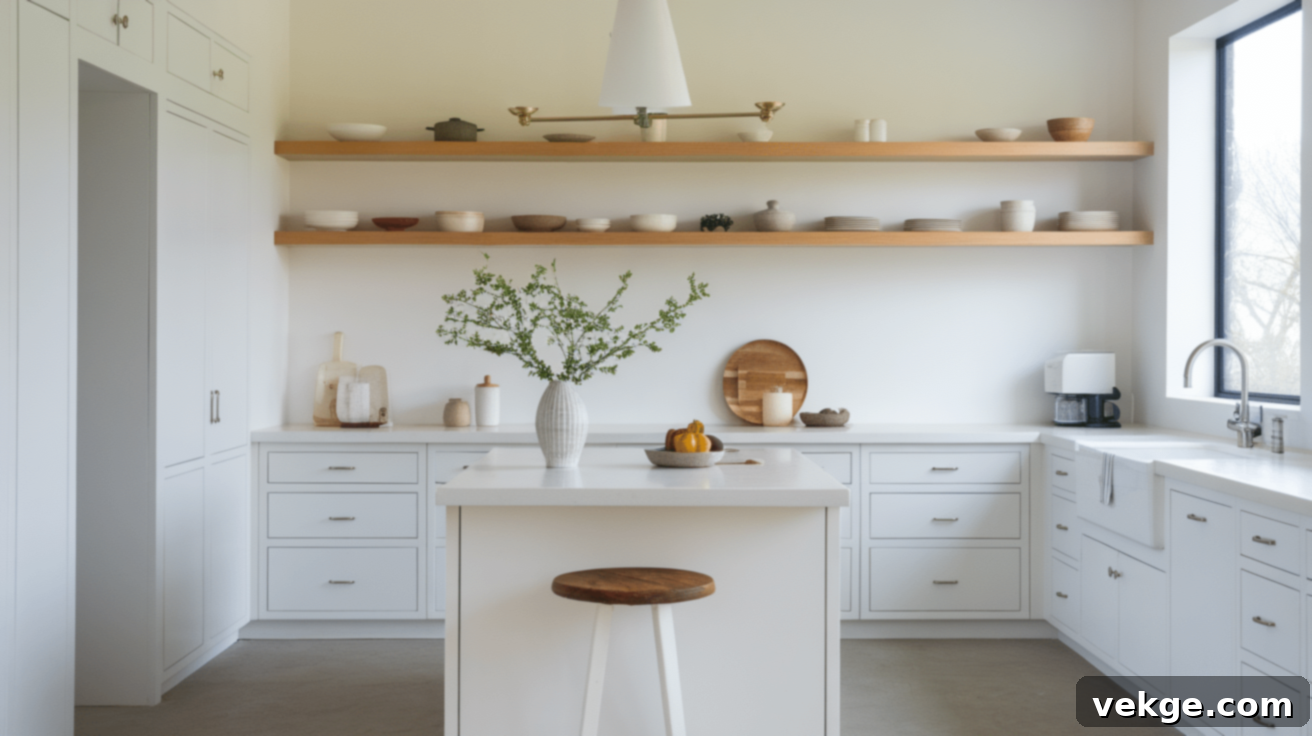
Minimalist cabinet designs embody the essence of “less is more,” featuring clean lines, handle-less fronts (often achieved with push-to-open mechanisms or integrated finger pulls), and an absolute absence of superfluous decoration. This style is the epitome of modern, serene kitchen aesthetics, where the focus shifts from intricate details to the inherent beauty of quality materials, harmonious proportions, and an uncluttered environment. It champions visual simplicity and an orderly, calm atmosphere.
These cabinets create a remarkably calm, ordered, and spacious feeling in the kitchen. Their simple profiles and often monochromatic or muted color palettes make them highly versatile, pairing effortlessly with a wide variety of countertop materials (like concrete or quartz), backsplashes, and flooring options. A minimalist approach allows for subtle textures and natural elements to truly stand out, fostering an atmosphere of tranquility and refined simplicity. It’s about quiet luxury and purposeful design, where every element has a reason to be there.
13. Floating Cabinets: Enhancing Visual Space
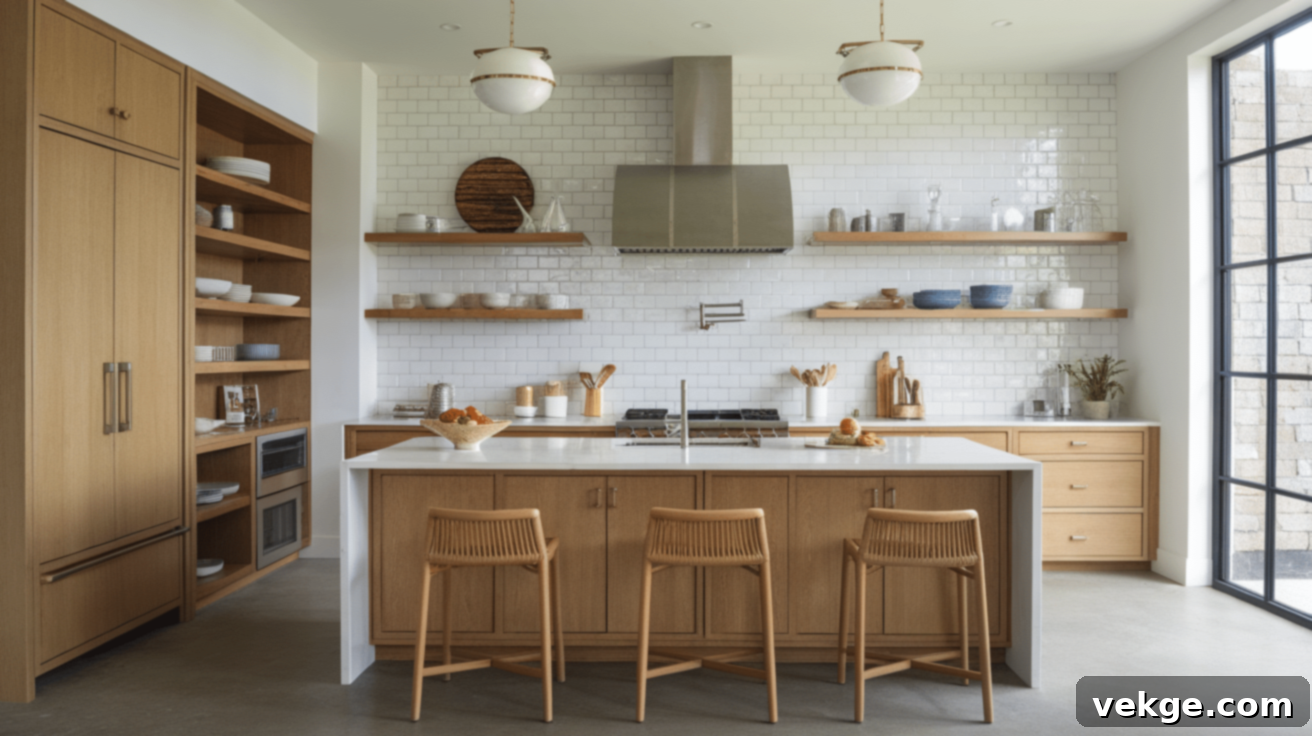
Floating cabinets, mounted directly to the wall without reaching the floor, create a striking visual effect where they appear to “float” effortlessly in the space. This contemporary storage solution introduces a profound sense of openness and lightness to kitchens, making them feel more expansive and less grounded. They are often integrated with subtle LED lighting underneath to enhance the floating illusion and add ambient light, contributing to a modern and airy feel.
By lifting the cabinetry off the floor, the room gains significant visual space, making it feel larger, airier, and more modern. This style is exceptionally effective in smaller kitchens, where every visual trick to expand the space is valuable. It also works beautifully in homes with open-plan layouts, allowing the kitchen to flow seamlessly into adjacent living and dining areas, maintaining an uncluttered and sophisticated aesthetic. Furthermore, the space beneath floating cabinets can be easily cleaned, adding a practical benefit.
14. Natural Wood Finishes: Organic Warmth and Timeless Appeal
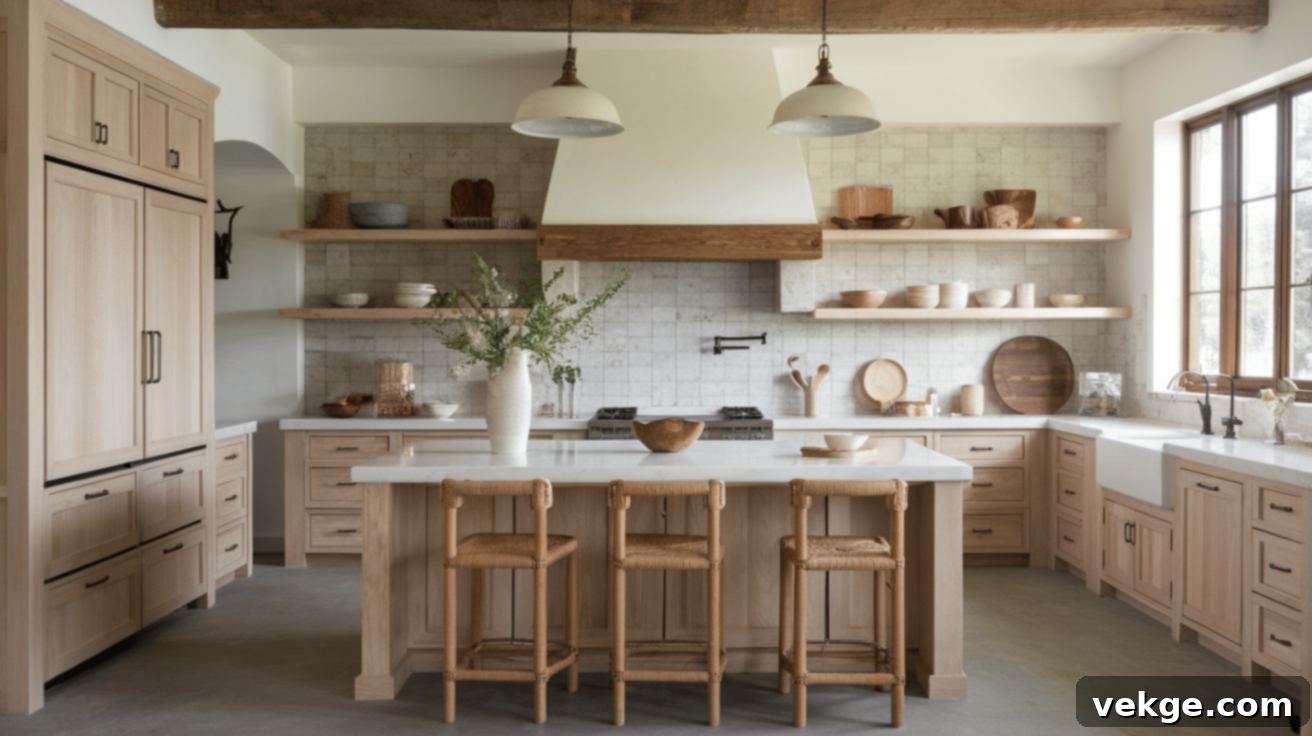
The beauty of raw or lightly finished wood cabinetry is experiencing a significant revival, offering an organic warmth and rustic elegance that transcends passing fads. Natural materials are increasingly sought after for their inherent connection to nature, their unique grain patterns, and their ability to create an inviting, authentic, and cozy atmosphere. This trend celebrates the imperfections and inherent character of real wood, bringing a touch of the outdoors inside.
These cabinets effectively bring the serene beauty of the outdoors inside, instantly adding warmth, texture, and a sense of grounding to kitchen spaces. Light oak, rich walnut, pale maple, and even more rustic hickory tones are particularly popular, as they create a welcoming feeling while proudly showcasing the wood’s distinctive grain patterns and natural variations. Natural wood finishes are incredibly versatile, fitting seamlessly into farmhouse, Scandinavian, mid-century, and even modern minimalist designs, ensuring lasting aesthetic value and a comforting ambiance.
15. Sustainable Materials: Eco-Conscious Kitchens
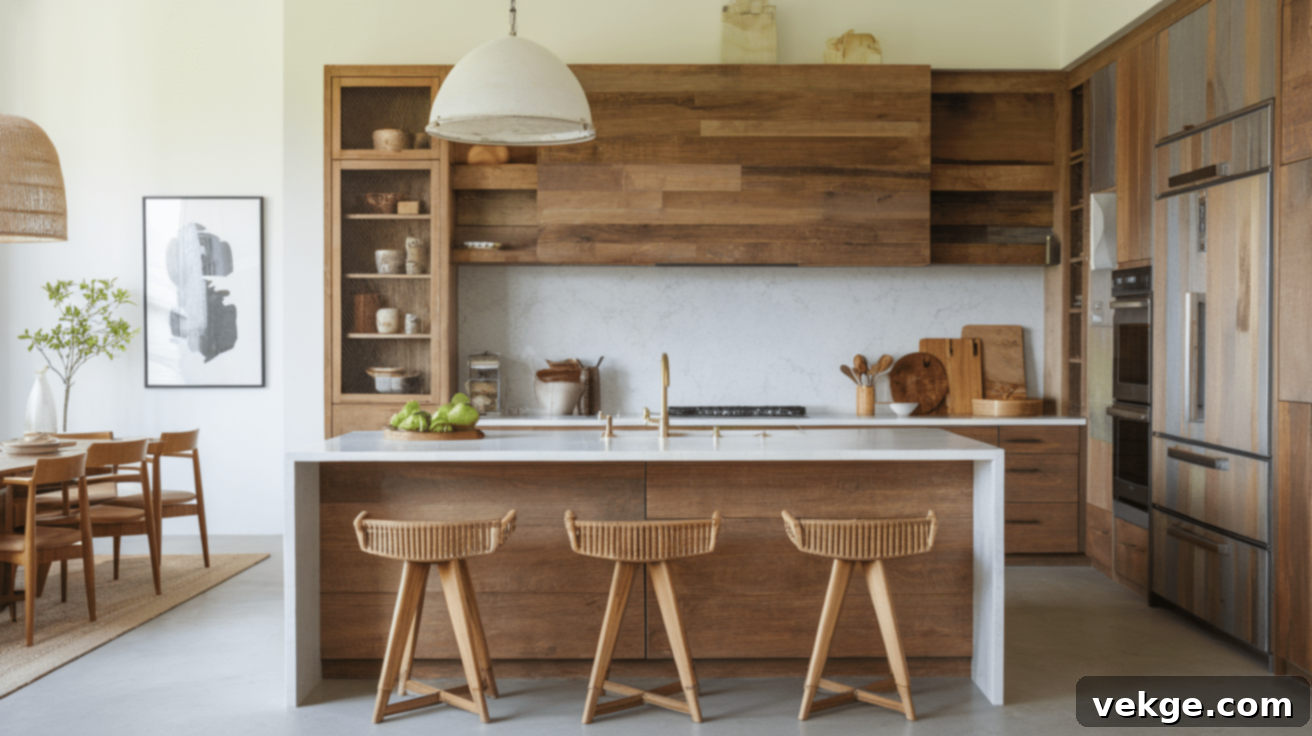
As environmental awareness grows, so does the demand for eco-friendly design options in the kitchen. Cabinets crafted from sustainable materials, such as reclaimed wood, rapidly renewable bamboo, recycled content (like recycled glass or plastic composites), or those utilizing low-VOC (volatile organic compound) finishes, are becoming increasingly popular. This trend allows homeowners to make environmentally conscious choices without sacrificing style, quality, or durability, contributing to a healthier planet and home.
Opting for sustainable cabinet materials significantly helps reduce waste, conserves natural resources, and often promotes healthier indoor air quality by minimizing the release of harmful chemicals. Many homeowners are now actively seeking to align their kitchen designs with their personal values regarding environmental protection. These materials offer both aesthetic appeal and the peace of mind that comes from making responsible choices, proving that beautiful design can also be green, ethical, and high-performing.
16. Mixed Cabinet Materials: Richness in Texture and Visual Interest
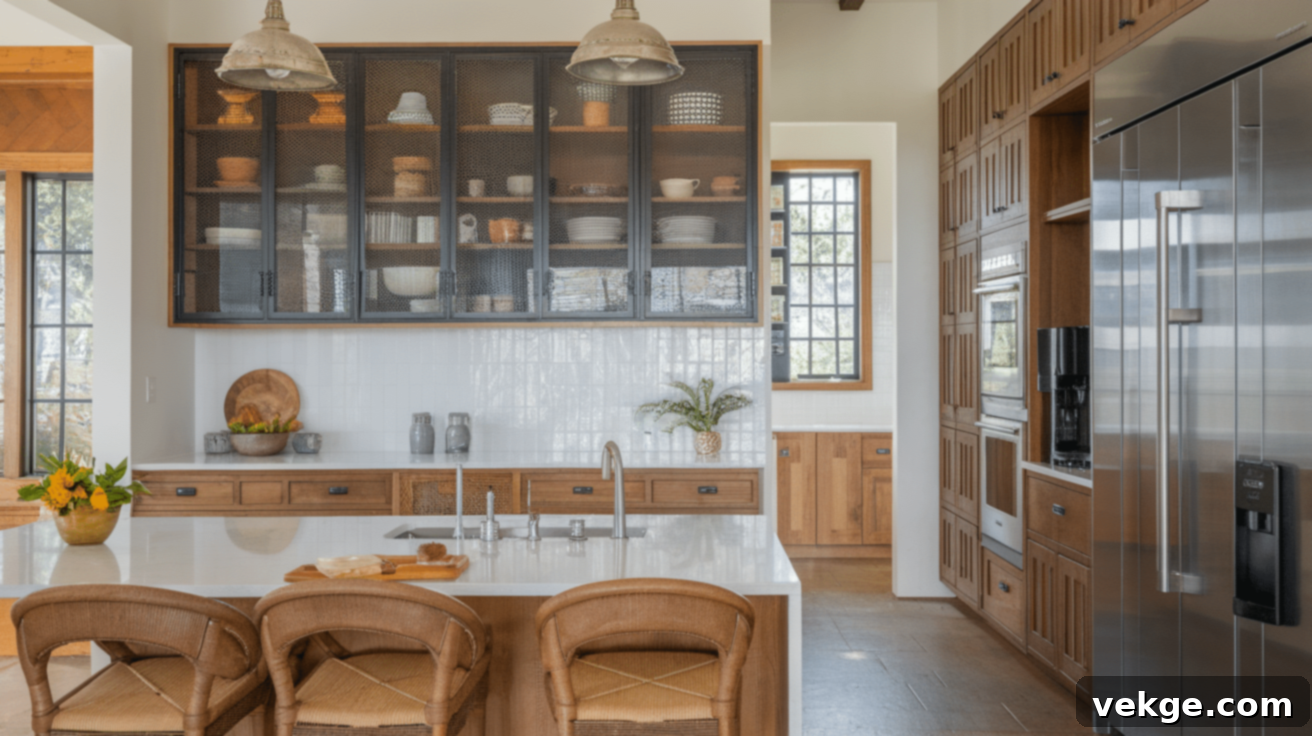
The trend of combining different materials within kitchen cabinetry offers a sophisticated way to create a highly personalized look, rich in varied textures and visual interest. Instead of a uniform presentation, this approach blends diverse elements like warm wood with cool metal, transparent or frosted glass, or robust stone, resulting in a dynamic and layered design that prevents the kitchen from feeling one-dimensional.
Mixing materials helps to break up large expanses of cabinetry, adding character, depth, and a bespoke feel to the kitchen. Popular combinations often include classic wood cabinets accented with frosted or clear glass doors for display, contemporary metal frames on certain units, elegant stone inlays on island fronts, or even textured laminates paired with solid wood. This trend allows for immense creative expression and can highlight specific zones or features within the kitchen, making it truly unique and visually engaging.
17. Matte Finishes: Understated Sophistication and Practicality
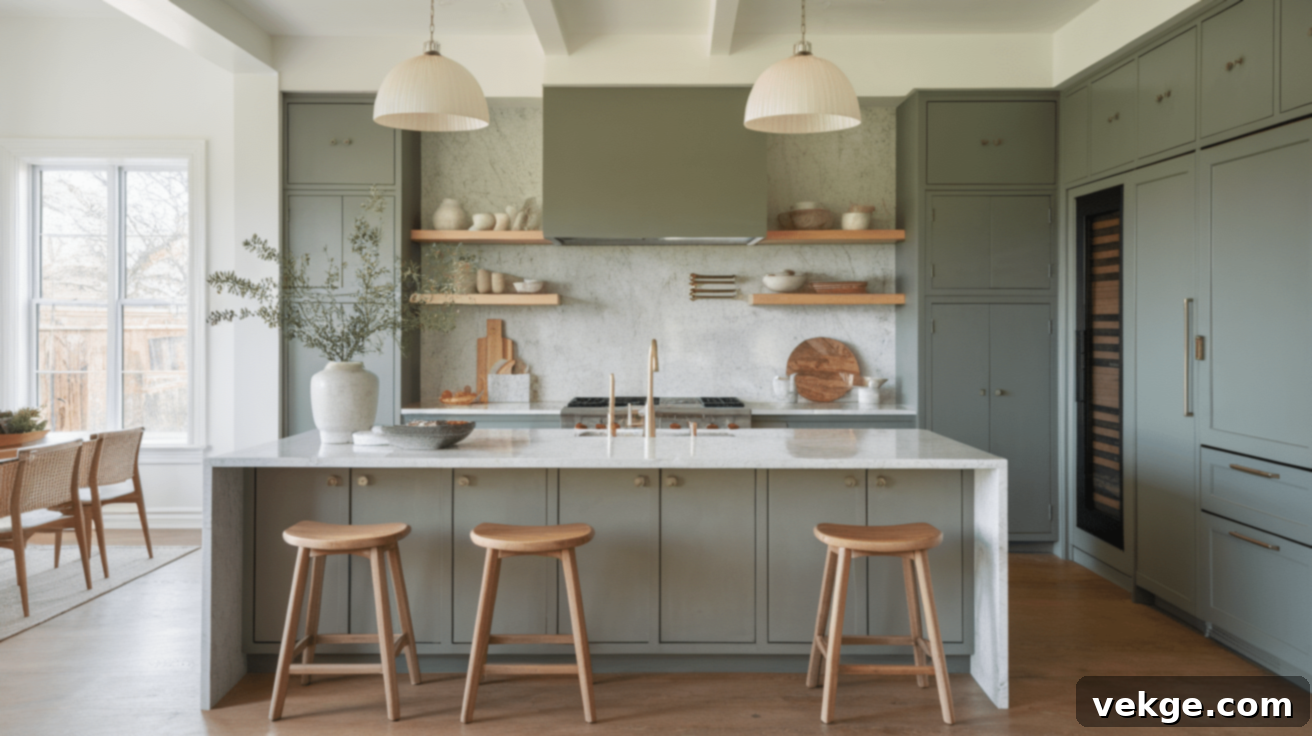
Moving away from highly reflective, glossy surfaces, matte finishes offer a more subtle, refined, and contemporary look for kitchen cabinets. The subdued, non-shiny appearance of matte cabinets exudes an understated sophistication that feels both modern and luxurious. This finish absorbs light rather than reflecting it, creating a soft, velvety texture that adds depth to colors and prevents harsh glares, fostering a calm ambiance.
Beyond their aesthetic appeal, matte finishes are also highly practical for busy kitchens. They are notably more forgiving than glossy surfaces, as they tend to hide fingerprints, smudges, and minor imperfections far better, requiring less frequent cleaning and touch-ups. This practicality, combined with their warm and inviting yet distinctly modern feel, makes matte cabinets an increasingly popular choice for homeowners seeking both lasting style and low maintenance without sacrificing elegance.
18. Large-Scale Cabinets: Maximizing Vertical Storage
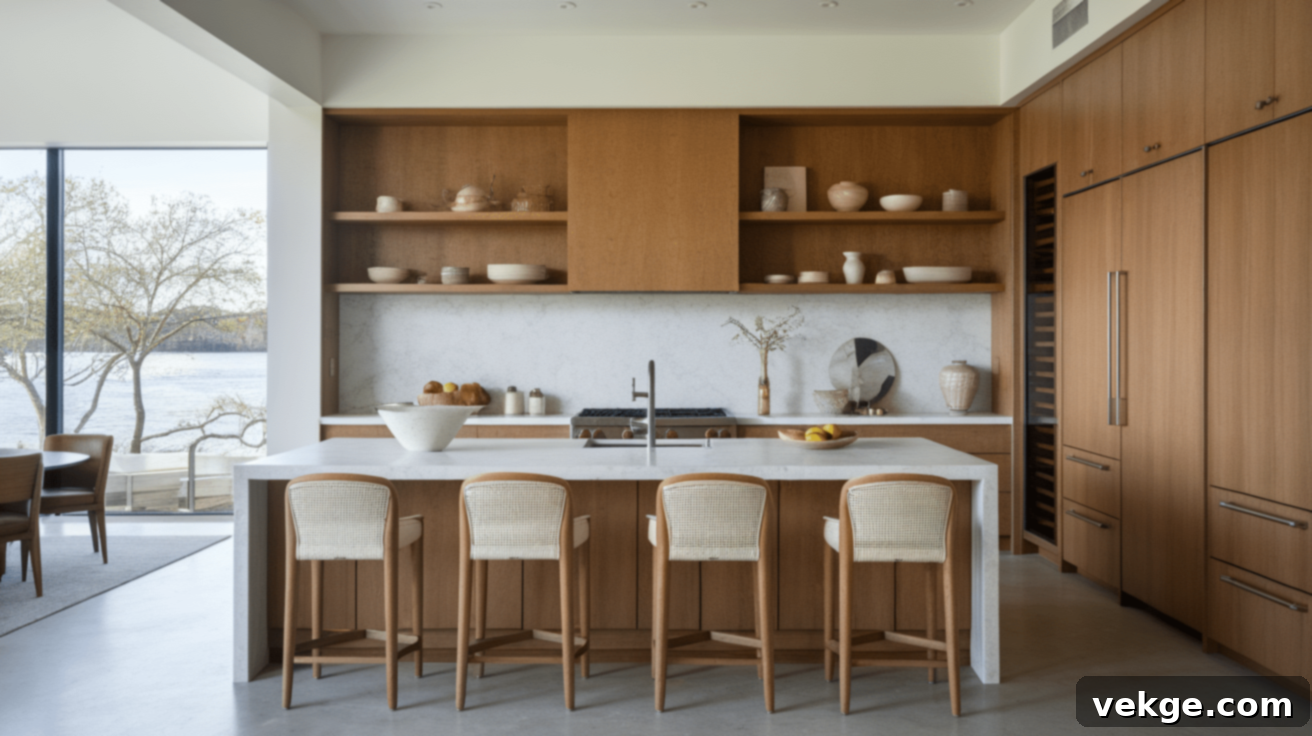
Large-scale or floor-to-ceiling cabinets are a powerful design solution that maximizes vertical storage potential, especially beneficial in kitchens with high ceilings or limited floor space. By extending cabinetry all the way to the ceiling, homeowners gain invaluable extra storage for items used less frequently, seasonal decor, bulk pantry goods, or even specialized culinary equipment, keeping the kitchen organized and beautifully clutter-free.
Beyond their practical benefits, these oversized cabinets also create a visually striking, unbroken line that draws the eye upward, making ceilings appear even higher and the room feel more grand and expansive. This streamlined look contributes to a clean, custom-built aesthetic, making the kitchen feel more thoughtfully designed and integrated. They can be particularly effective in minimalist or contemporary designs where seamless surfaces and maximum hidden storage are desired, creating a sleek, almost monolithic appearance.
19. Exposed Hardware: Jewelry for Your Cabinets
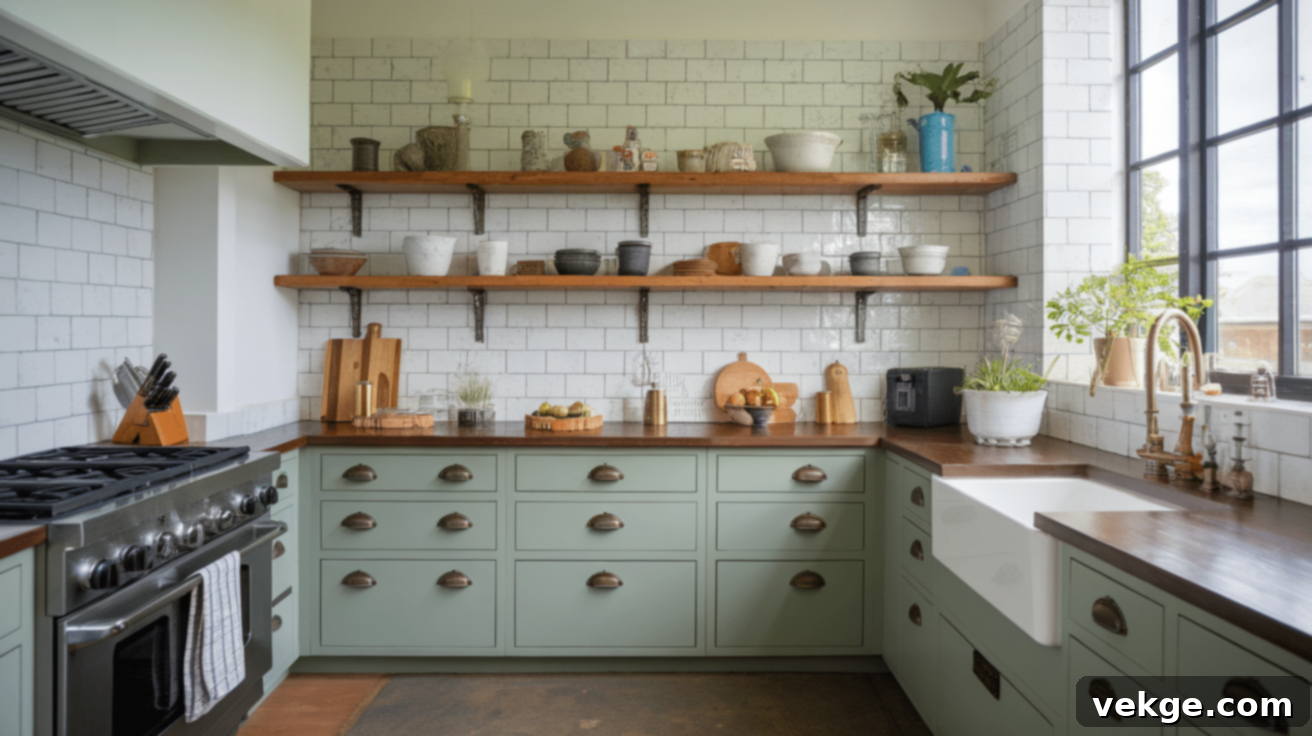
In contrast to handle-less designs, the trend of exposed, stylish hardware celebrates the decorative potential of cabinet pulls, knobs, and handles. These visible elements act like “jewelry” for your cabinets, adding a crucial touch of character and allowing for immense creative personalization. From sleek minimalist bars and rustic industrial pulls to ornate vintage knobs or elegant leather straps, carefully chosen hardware can define the cabinet’s style and elevate the entire kitchen’s aesthetic.
Thoughtfully selected hardware can completely transform the look and feel of your kitchen, providing an opportunity for homeowners to express their unique style without undertaking a full renovation. Mixing metals (e.g., brass with matte black, or brushed nickel with polished chrome) and textures (e.g., leather pulls with polished wood) creates additional visual interest and a sophisticated layered effect. It’s an accessible and high-impact way to update kitchen aesthetics, making even standard cabinets feel custom and luxurious.
20. Metallic Accents: A Touch of Luxury and Shine
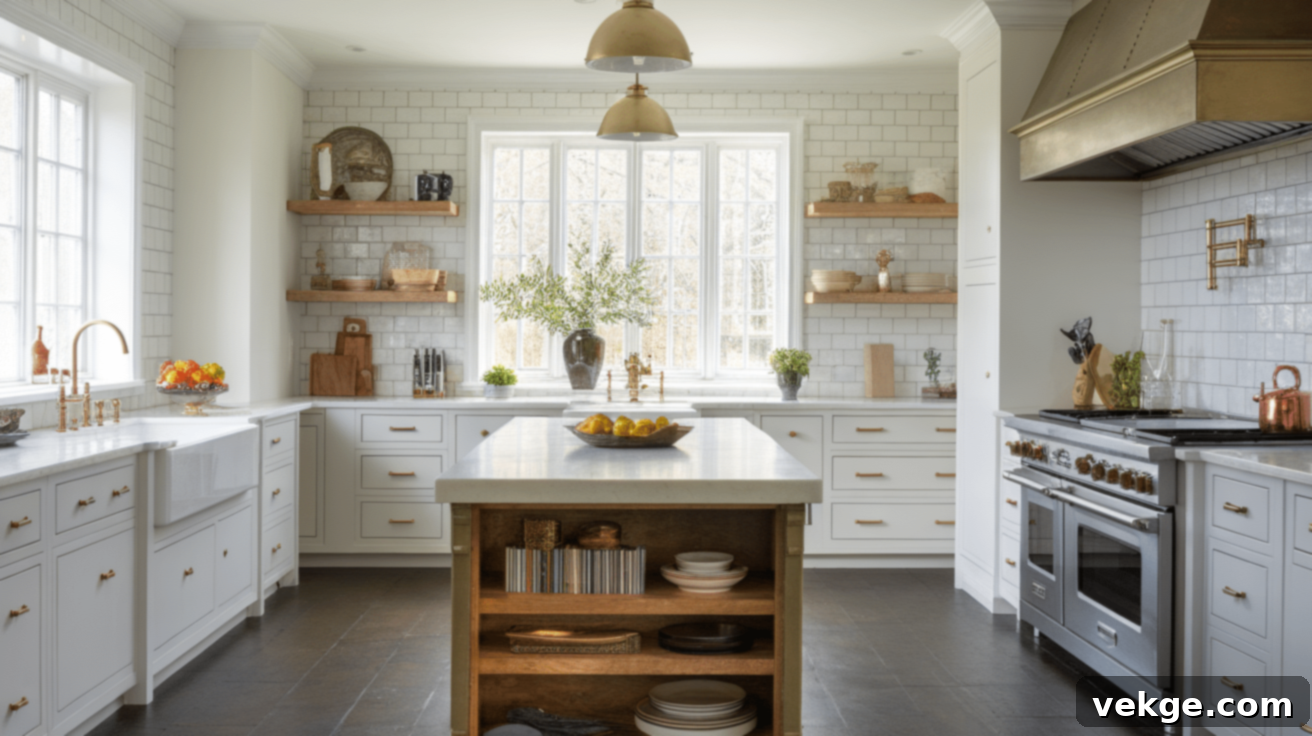
Incorporating metallic elements into cabinetry, whether through hardware, subtle trims, or integrated finishes, instantly infuses kitchen designs with a touch of luxury, sophistication, and refined sparkle. Metals introduce an element of glamour and can dramatically elevate the overall aesthetic, making a kitchen feel more opulent, modern, and curated. They add a sophisticated shimmer and a focal point that draws the eye.
Polished brass, warm copper, sleek brushed nickel, and striking matte black finishes are especially popular choices that pair beautifully with a wide range of cabinet colors and materials. These metallics stand out exquisitely against both neutral and bold cabinet colors, providing a captivating contrast. Even small details, like elegant cabinet pulls, decorative toe-kick accents, or a metallic inlay on an island, can have a significant impact, allowing for a quick yet impactful update to a kitchen without the need for major structural changes. They catch the light and add visual dynamism.
21. Textured Cabinet Finishes: Depth and Sensory Appeal

Moving beyond purely smooth surfaces, textured cabinet finishes add an exciting new dimension to kitchen design. Surfaces with subtle patterns, such as ribbed, fluted, reeded, woven wood, or even concrete-effect designs, introduce tactile interest and visual depth that flat cabinets simply cannot achieve. This trend appeals to both sight and touch, making the kitchen a more sensory-rich and engaging environment, inviting interaction and exploration.
Unlike perfectly flat cabinets, textured designs create dynamic shadow play and a sophisticated sense of dimension, making them inherently more engaging and luxurious to behold. These subtle patterns add significant character and bespoke charm without being overwhelming, allowing for a refined aesthetic that stands out. They can soften hard lines, provide a unique focal point in a modern kitchen, or add an organic touch, enhancing its overall tactile and visual appeal and making the space feel richer and more complex.
22. Bold Cabinet Hardware: Making a Statement
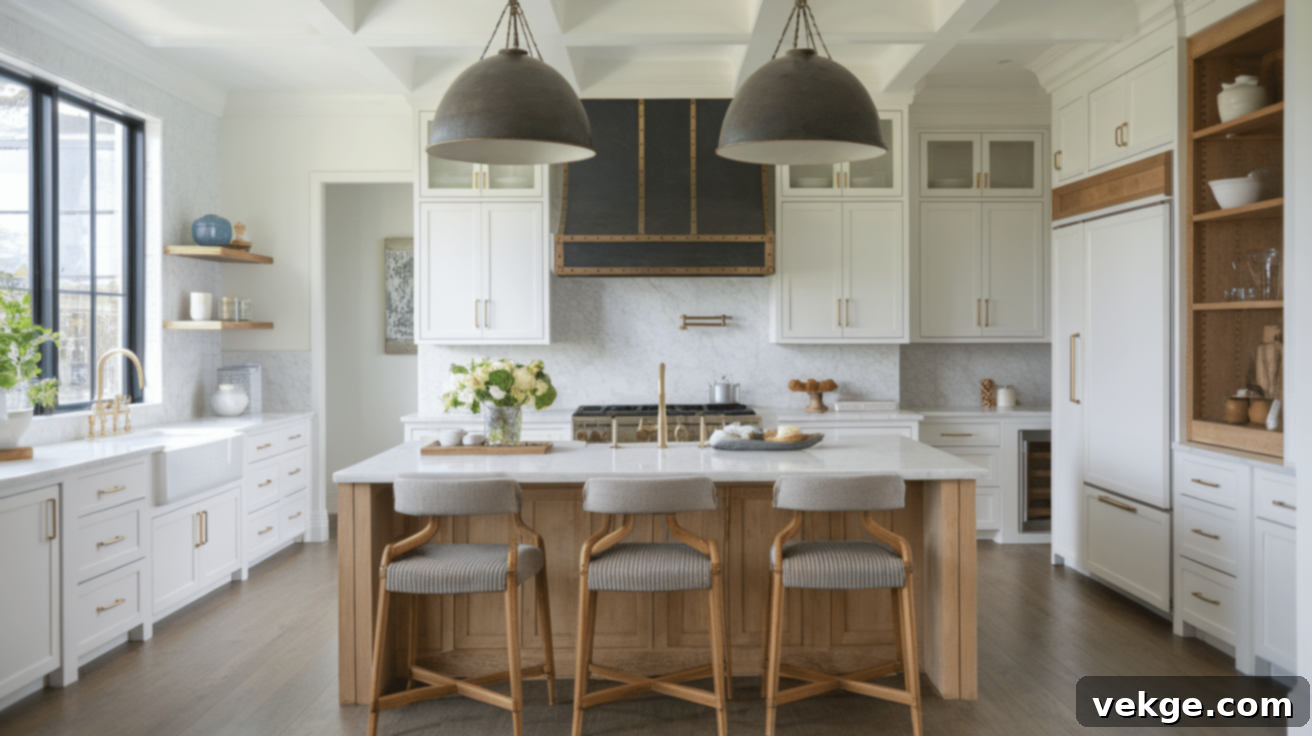
Beyond merely exposed hardware, the trend of bold cabinet hardware takes personalization to the next level by utilizing large, eye-catching handles, oversized pulls, or uniquely shaped knobs. In this design approach, cabinet hardware is no longer just a functional component but becomes a deliberate focal point, a piece of art that defines and enhances the overall kitchen aesthetic. It’s an opportunity to inject personality and an element of surprise into the design.
Statement hardware pieces have the remarkable ability to completely transform the look of existing cabinets without the need for expensive replacements. This makes it an incredibly affordable and high-impact way to update a kitchen’s style and express individual taste. Whether it’s a chunky bronze bar, an elegant leather strap pull, an artistic ceramic knob, or a uniquely shaped geometric design, bold hardware offers a powerful design punch that can significantly elevate the kitchen’s character and modernity. It’s a small detail with a big impact.
23. Mixed Cabinet Heights: Dynamic Visual Interest
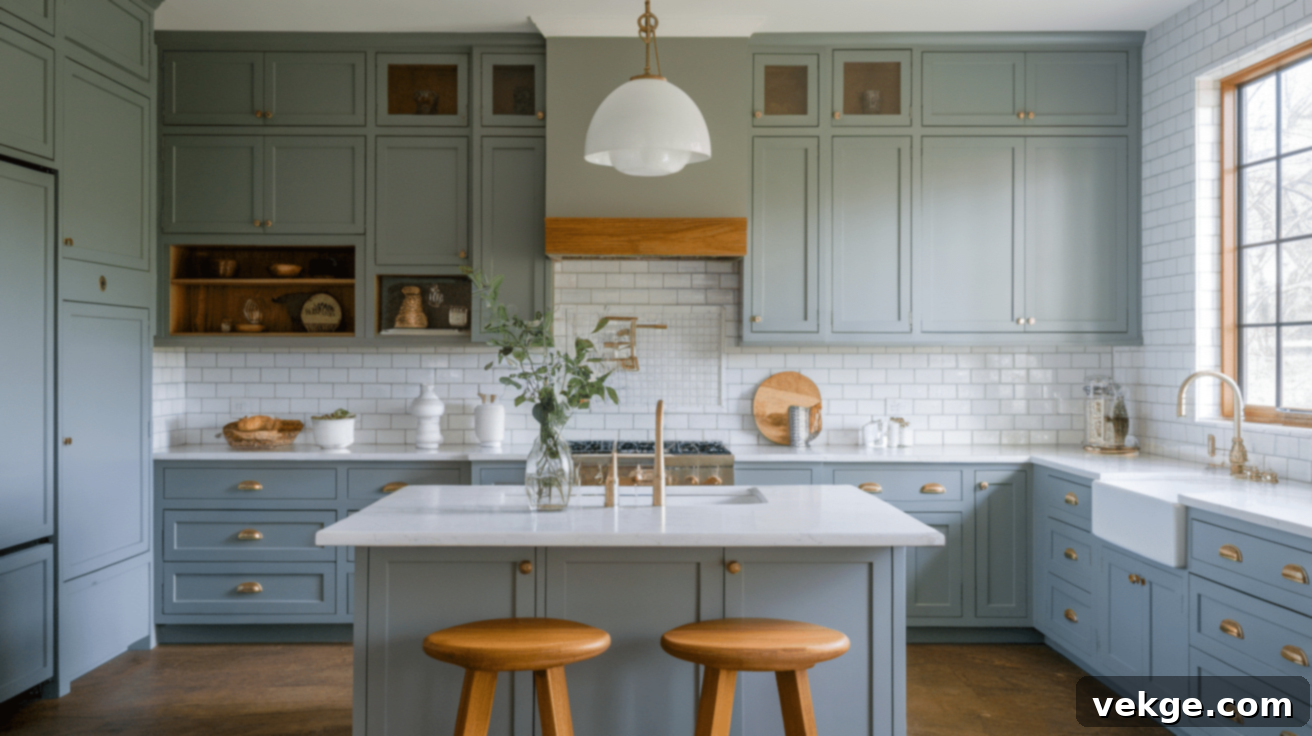
Breaking away from uniform rows of upper cabinets, the trend of mixed cabinet heights offers a unique, asymmetrical, and highly dynamic look. This approach introduces a sense of visual movement, architectural interest, and creative freedom into the kitchen, making it feel less utilitarian and more custom-designed. It allows for a playful yet sophisticated composition of forms and lines, adding a custom, bespoke feel to the space.
Varying cabinet heights can strategically break up the visual monotony of a long wall and highlight special features within the kitchen, such as a statement range hood, a unique backsplash, or an open shelving display. This style works exceptionally well in larger kitchens with high ceilings, where it can add architectural complexity and prevent the space from feeling too cavernous. It creates a bespoke, artful arrangement that is both functional, allowing for different storage needs, and visually engaging, adding depth and character.
24. Classic White Cabinets: Enduring Elegance
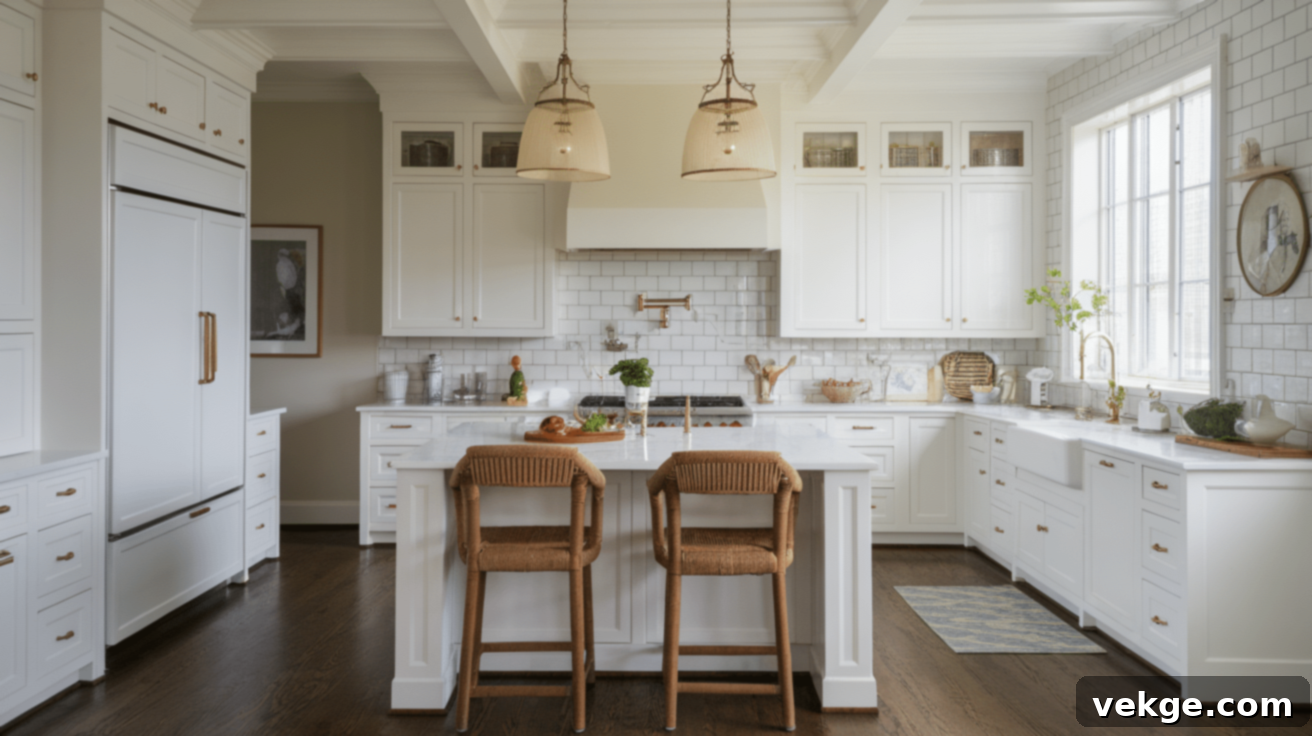
Despite the emergence of countless new and exciting trends, classic white cabinets steadfastly remain a timeless staple in kitchen design. Their enduring appeal lies in their unparalleled versatility, ability to create a clean and bright aesthetic, and the flexible foundation they provide for future kitchen updates and decor changes. White cabinets are never truly “out of style” because they are a foundational neutral that offers limitless design possibilities.
White cabinets inherently create a bright, spacious, and pristine look, making even the smallest kitchens feel larger and more open by reflecting light. They serve as a perfect backdrop for any accent color, material, or design element you wish to introduce, from vibrant backsplashes to unique flooring or colorful appliances. White works seamlessly with virtually any style, from sleek modern and industrial to charming farmhouse and traditional, ensuring lasting appeal and broad market desirability. For those who prefer a less stark look, opting for warmer off-whites, creams, or even light greys can still provide the brightness without feeling cold.
25. European-Style Cabinets: Sleek Functionality and Modern Minimalism
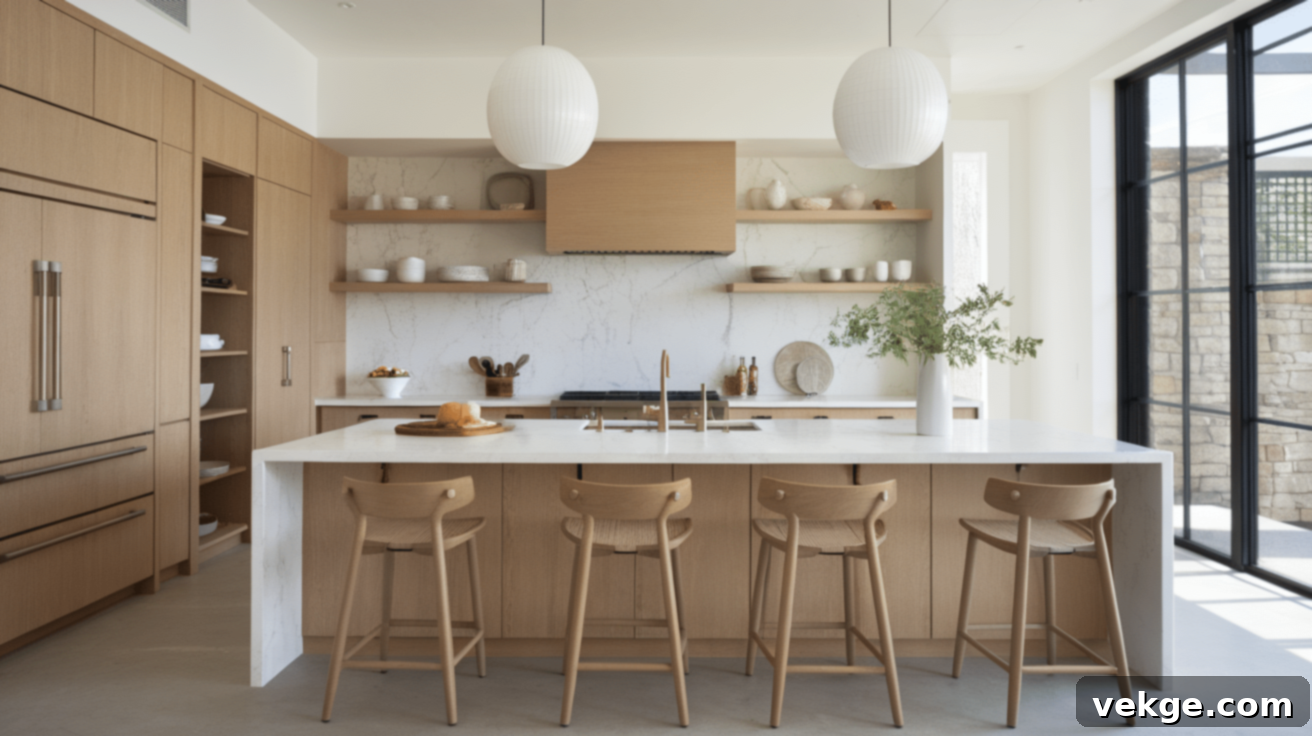
European-style cabinets emphasize sleek, minimalist lines, frameless construction, and a strong focus on functionality. These influences are increasingly permeating American kitchen designs, bringing a sophisticated, streamlined aesthetic that prioritizes clean, uncluttered spaces. Often characterized by full-overlay doors (where the door completely covers the cabinet box, leaving minimal gaps), handle-less designs (using push-to-open mechanisms or integrated pulls), and compact proportions, they offer a very contemporary and refined look.
This design philosophy celebrates good materials and smart, integrated storage solutions over excessive ornamentation. European-style cabinets are remarkably versatile and work well in kitchens of all sizes, making them particularly effective in urban apartments or smaller homes where space optimization and an expansive feel are key. Their simple, functional approach creates a highly efficient and visually calm environment, allowing the quality of the materials and the precision of the design to speak for themselves, resulting in a clean, sophisticated, and highly functional kitchen.
What Kitchen Cabinet Trends are Out of Style and Best to Avoid?
While design trends are cyclical, certain kitchen cabinet styles have definitely fallen out of favor, now appearing dated and often detracting from a home’s value rather than enhancing it. Being aware of these fading trends can save you from making an investment that quickly loses its appeal and requires another update sooner than desired.
One prominent style to reconsider is **overly ornate cabinets with heavy carvings, busy details, and excessive embellishments.** Think Victorian-era fussiness, highly distressed finishes designed to look artificially aged, or prominent raised panels with intricate trim. Modern homeowners now strongly prefer cleaner lines and a more understated elegance, even within classic or traditional styles. The intricate detailing, once a symbol of luxury, now often reads as cluttered, heavy, and dust-collecting, making a kitchen feel smaller, less serene, and often quite busy visually.
The once ubiquitous **”all-white kitchen” with high-gloss, sterile finishes** is also losing its dominance. While white remains a classic, the cold, clinical feel of a monochrome, highly reflective white space can feel unwelcoming, impersonal, and stark. Instead, homeowners are now gravitating towards warmer whites, off-whites, and creams, often paired with natural wood elements, contrasting colors, or subtle textures to add warmth, depth, and character. The aim is for an inviting brightness, not a hospital-like sterility, focusing on layers of complementary tones rather than a single, stark hue.
Finally, **poorly proportioned or overly matched cabinet hardware** is a common misstep. This includes either excessively oversized, highly ornate pulls that overwhelm the cabinet doors, making them look clunky, or, conversely, tiny, generic knobs that get lost in the design, failing to provide a visual anchor. Another outdated approach is insisting that all metal finishes in the kitchen (faucets, lighting fixtures, and cabinet hardware) must perfectly match. Today’s design aesthetic prefers thoughtfully chosen hardware that complements the cabinet style and scale, and a sophisticated mix of metallic finishes is welcomed. This creates visual interest and depth rather than a monotonous, unbalanced look that lacks personality.
Tips for Choosing the Right Kitchen Cabinet Style for Your Home
Selecting the perfect kitchen cabinets is a pivotal decision that impacts both the aesthetics and functionality of your entire home for years to come. The ideal cabinets should harmonize with your daily routine, the physical dimensions of your kitchen, and your personal design preferences, all while comfortably fitting within your budget. Here are some expanded tips to guide you through the decision-making process, ensuring you make an informed choice:
- Consider Your Kitchen’s Size and Layout: The physical space of your kitchen should heavily influence your cabinet choices. For smaller kitchens, lighter cabinet colors (like white, cream, or pale gray) and simpler door styles (such as Shaker or flat-panel) are often the best choices. These options prevent the space from feeling overwhelmed, reflect natural light, and make the room appear larger and airier. In contrast, larger kitchens can accommodate darker, bolder colors, more intricate designs, or mixed material approaches, allowing for more dramatic statements without feeling cramped.
- Balance Timelessness with Current Trends: To ensure your kitchen remains stylish and doesn’t quickly feel dated, aim for a thoughtful blend of enduring classic elements and contemporary trends. Incorporate lasting styles like Shaker panels, classic wood finishes, or neutral base tones for the majority of your cabinetry. Then, introduce current trends through accent pieces, a colorful island, unique and bold hardware, open shelving, or a statement backsplash. This strategy allows you to embrace modernity without the risk of your kitchen quickly becoming outdated, maximizing your investment’s longevity.
- Reflect Your Lifestyle and Practical Needs: Your cabinets should cater precisely to how you actually use your kitchen on a daily basis. If you are an avid cook and entertainer, prioritize cabinets with highly practical storage solutions, such as pull-out pantries, deep drawers for pots and pans, integrated spice racks, and smart appliance garages. If you entertain frequently but cook less, consider display-friendly options like glass-front cabinets or open shelving to showcase your dinnerware, glassware, or decorative items. Functionality and ease of use should always be a key driver in your choices.
- Harmonize with Your Home’s Overall Aesthetic: Ensure your chosen cabinet style complements the architectural style and existing decor of the rest of your home. A sleek, ultra-modern, handle-less kitchen might feel out of place in a charming Victorian-era house, just as overly ornate, traditional cabinets could clash with a minimalist, open-concept contemporary home. Strive for visual continuity and a cohesive design language throughout your living spaces to create a harmonious and unified environment that flows naturally.
- Experiment with Material and Finish Combinations: Don’t be afraid to mix and match different elements! Using different cabinet materials, colors, or finishes within the same kitchen can create dynamic visual interest and a truly personalized touch that adds character. For instance, pairing natural wood lower cabinets with painted upper cabinets, combining matte finishes with a touch of metallic hardware, or incorporating glass inserts in some doors adds depth and sophistication. This approach allows you to highlight different zones and textures in a tasteful, layered manner.
- Factor in Maintenance and Durability: Beyond aesthetics, think about the practicalities of upkeep and the longevity of your chosen materials. High-gloss finishes, while striking, show fingerprints, smudges, and scratches more readily than matte options. Natural wood requires specific care and can be susceptible to moisture if not properly sealed, while laminate or thermofoil can be more low-maintenance and durable for busy households. Choose materials and finishes that can withstand the rigors of your household and that you are prepared to maintain over time. Durability is key for a long-lasting and beautiful kitchen.
- Set a Realistic Budget: Cabinetry typically represents a significant portion of a kitchen renovation budget, often 30-40% or more. Research different cabinet options (e.g., custom, semi-custom, stock) and their associated costs early in your planning phase. Be transparent with your designer or contractor about your budget to explore the best possible options that meet both your aesthetic desires and financial constraints. Sometimes, a strategic combination of higher-end elements and more affordable options can achieve a luxurious look within a sensible budget.
Conclusion: Crafting Your Dream Kitchen with Timeless Cabinetry
Kitchen cabinets are undeniably the foundational element of any kitchen design, setting the primary tone and defining the character for the entire room. The exciting array of trends emerging this year offers an abundance of choices, ensuring there is something to inspire every homeowner, from the allure of bold colors and the grounded appeal of natural woods to the intelligent efficiency of smart storage solutions and the sophisticated artistry of mixed materials. These trends allow for unprecedented personalization and functionality.
Whether you are embarking on the ambitious journey of a full kitchen remodel or simply aiming to rejuvenate your existing space with a thoughtful update, embracing these contemporary cabinet styles can profoundly enhance both its visual appeal and its daily functionality. The right cabinets not only store your essentials but also elevate your cooking experience, streamline your routines, and transform your kitchen into a true sanctuary—a space that is both practical and beautiful.
By carefully selecting cabinets that truly reflect your personal style and meticulously address your practical needs, you will create a kitchen that feels both exquisitely current and wonderfully comfortable. This careful consideration ensures your investment will continue to delight and serve you well for many cherished years to come, solidifying your kitchen as the vibrant and welcoming heart of your home, a place where memories are made and shared.
